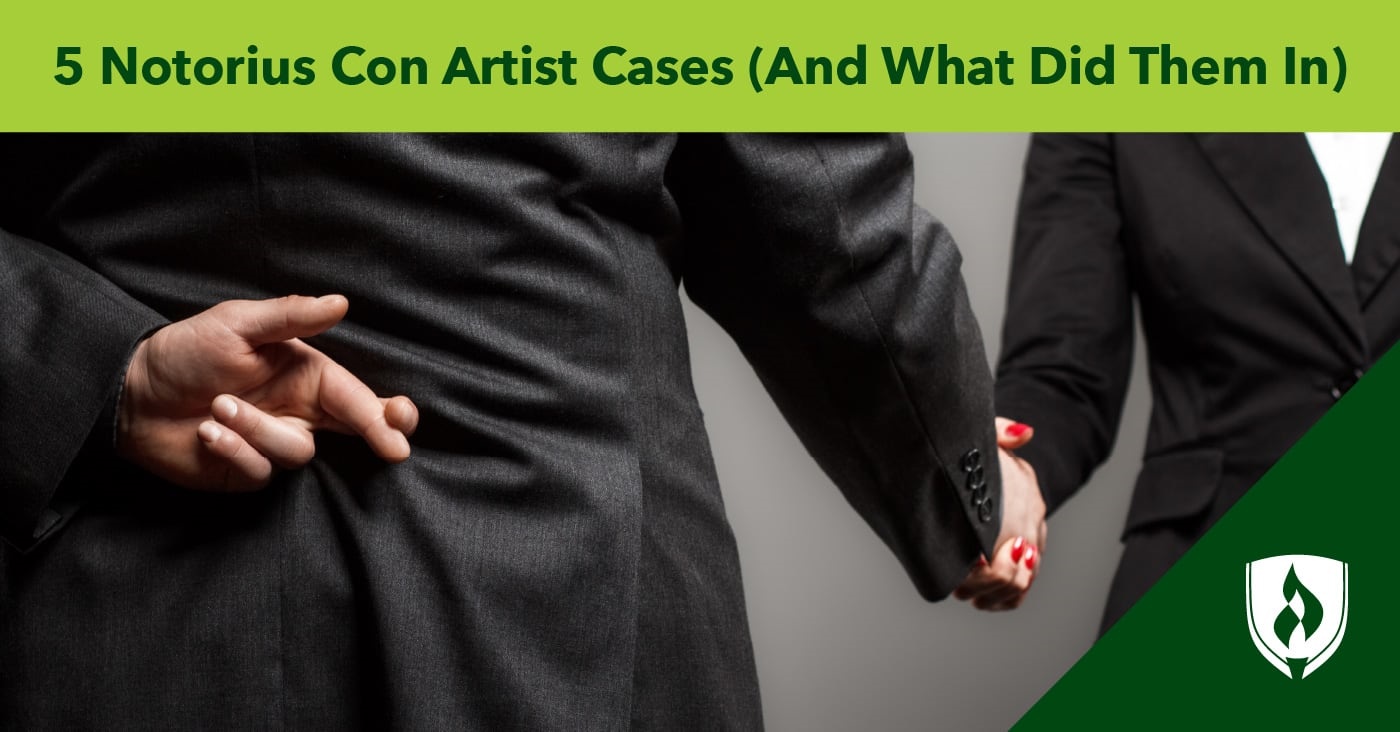
Con artists occupy a unique place in our culture. These scoundrels have caused untold financial hardship, often by preying on our psychological weaknesses—and yet we can’t help but be fascinated by their portrayals in pop culture. Whether they are presented in a sympathetic light or not, their stories have grabbed the attention of people from all around the world. Their exploits occupy our minds with questions concerning how they did it, how the people around them fell for it and ultimately, what happens to them when they get caught.
Their stories carry with them a natural tension and drama that lends itself perfectly to Hollywood. Let’s take a closer look at some of these fascinating (and aggravating) individuals by first defining exactly what a con artist is and discovering what laws they generally break.
What is a con artist?
To con someone is to knowingly deceive or take advantage of an individual after you have gained their confidence. Con artists can often be hard to prosecute criminally because they skirt the boundary between what is simply unethical and what is actually illegal. Those who do face justice are often guilty of a form of fraud.
In legal terms, fraud is when a party knowingly misrepresents the truth (or knowingly conceals material facts) in order to get another party to act to their own detriment.
Many con artists face legal consequences when it can be proven that they have committed some form of fraud. Some of the most common types of fraud include:
- Mail fraud: Using the postal service in any scheme to try and procure funds through dishonest means is a federal offense (whether it is successful or not).
- Wire fraud: Probably the broadest term for fraud, it refers to any individual who uses a telephone, electronic communication device or a computer in their crimes.
- Computer and internet fraud: Specific to computer and internet fraud, this includes things like identity theft, phishing schemes, charitable contribution fraud, employment fraud and investment fraud conducted online.
- Loan fraud: This is when an individual or business knowingly makes a false, material statement to a bank, financial institution, mortgage lender or federal agency to obtain a loan.
- Counterfeiting: Anyone that makes fake currency, documents or goods can be guilty at both state and federal levels of counterfeiting fraud.
- Credit card fraud: Obtaining, using or forging a credit card not your own or without the permission of the individual falls in this category.
History is full of con artists who have taken advantage of people who trusted them. While their stories and methods change over time, there are always cons looking to take advantage of the well-meaning people around them. Let’s take a closer look at a few of the most notable con artist stories.
A closer look at 5 of the world’s most infamous con artists
1. William Thompson
In the late 1840s, a man by the name of William Thompson went up to complete strangers on the streets of New York and asked a simple question: “Have you confidence in me to trust me with your watch until tomorrow?” Surprisingly enough, many individuals did! An article from the New York Herald in 1849 (https://lostmuseum.cuny.edu/archive/arrest-of-the-confidence-man-newyork-herald) describes the reasoning for individuals handing over the possessions to be based on the fact that Thompson was “of a genteel appearance,” and many thought he may “be some old acquaintance not at the moment recollected.” It is because of this article that the term “confidence man” or “con-man” became a part of our national vernacular.
How did he get caught?
Ultimately, someone he conned recognized him while walking on the street one day. The man went to a police officer nearby, and they were able to apprehend Thompson. He was arrested for theft, and the New York Herald called anyone who had been taken advantage of by Thompson to come and testify against him.
2. Charles Ponzi
You’ve most likely heard the term “Ponzi scheme” before. Charles Ponzi is its namesake. In the early 1900s, Ponzi was struggling to make ends meet. After receiving a letter from Spain, Ponzi had a novel idea–he would buy postal coupons from countries with weak economies and sell them to countries with stronger economies.
The scheme began when he pitched his idea to potential investors, promising to double their money in forty-five days. When his idea failed to create a profit, he brought in new investors, using their capital to pay off the initial investors. Those people reported their gains, causing more investors to trust Ponzi, and he began to pocket more and more of the invested money. Within eight months, Ponzi had brought in an estimated $15 million through roughly 40,000 investors.
How did he get caught?
It all began to change for Ponzi after he was sued by Joseph Daniels, and this caught the attention of the local papers. The Boston Post began digging into his company, and as more was coming to light about its illegitimacy, postal and legal authorities began to investigate him as well. Ultimately, he would be convicted of mail fraud. Ponzi spent the next fifteen years in and out of jail. When he died in 1949, he had $75 to his name.
3. Sylvia Browne
Sylvia Browne was a celebrity psychic in the late 20th century who had her own radio show and made regular appearances on the Montel Williams and Larry King Live television shows. For decades, Browne made her living from “communicating with the dead” and helping answer questions from individuals willing to pay $700 for thirty minutes of her suspect services.
The Skeptical Inquirer investigated Browne’s various claims. Of the 115 cases that they were able to review, Browne’s confirmable accuracy was 0 percent. Twenty-five of these cases showed Browne to be demonstrably wrong with the other ninety still being unsolved despite her help. Two of her more famously inaccurate predictions include a 2002 prediction where she told concerned parents that their son had been kidnapped and killed with his body somewhere by “two jagged boulders.” Four years later, he was found alive. In 2004, Browne again told grieving parents that their daughter was dead “in water.” 11 years later, the daughter was found, tragically, after her mother had passed away.
How did she get caught?
She didn’t—at least not connected to her predictions. 200 hours of community service for investment fraud was her only notable legal trouble. A quick scan of the internet today will tell you that she still has many followers who believe in her (and continue to buy her books). She continued her psychic readings until 2013 when she passed away at 77 years of age—notably another incorrect prediction for her as she had told Larry King that she was going to live until she was 88 years old.
4. Frank Abagnale
Safe to say, if a movie studio casts Leonardo DiCaprio to depict your life on the big screen, you’ve probably done something pretty noteworthy. By Frank Abagnale’s own estimation, the movie Catch Me If You Can is about 80 percent accurate to the events of his life. When Abagnale was just a teenager, he used his dad’s credit card at a gas station and convinced the attendants to give him cash back for the sale. Abagnale was quickly discovered by his father who sent him to a school for wayward boys before eventually running away at 16.
This is where Abagnale began his life of conning as he altered his license to make him look older (so he could get better jobs) and began to write hundreds of bad checks before needing to go on the run. Knowing that he would need to increase the ruse if he wanted to continue his scamming, Abagnale faked being a pilot by figuring out where to get a uniform using a fake employee ID. During this time, he flew all around the world before airlines and the police began to catch on. He also impersonated a town doctor in Georgia and cashed over $2.5 million in bad checks during his time on the run.
How did he get caught?
Unlike the movie, there wasn’t a prolonged encounter with an FBI agent on his trail. Abagnale attempted to settle down in France when the French police caught up to him thanks to a tip from an ex-girlfriend who recognized his face on a wanted poster. He was arrested for forgery, and his jail time included six months in a French prison, seven months in a Swedish prison and ultimately was sentenced to 12 years in federal prison.
5. Bernie Madoff
While Charles Ponzi is credited as being the inventor of the Ponzi scheme, Bernie Madoff actually executed the largest Ponzi scheme in history. Since Madoff’s con lasted decades, there have been numerous articles, books and even a miniseries that delve into all the sordid details.
In the 1960s, Madoff founded a small trading firm, which helped revolutionize the way stocks are traded. This success led him to launch an investment advisory business in the 1990s where his scheme began. Like Ponzi, Madoff paid investors with funds from his more recent investors, allowing his earlier investors to claim incredibly high returns. It was those high returns (and the satisfied investors) that allowed Madoff to get away with his scheme for so long that even banks looked the other way.
How did he get caught?
The economic crisis in 2008 caught up to him. Many of Madoff’s clients took out money faster than he could bring new investments in. He confessed to his brother and two sons the nature of his business, and they turned him in to federal authorities the next day. Madoff would plead guilty to 11 felony counts (fraud, money laundering, perjury) before being sentenced to 150 years in prison, where he later died.
A fascination with con artists
Con artists have always been fascinating (albeit quite flawed) people. Movies and TV shows for decades have pondered the intricacies of their plans and how they were able to get away with something for so long.
However, not every fictionalized re-telling gets everything right. If television’s accuracy versus real life interests you, check out “How Accurate are Crime Shows on TV? Debunking 7 Common Myths.”




